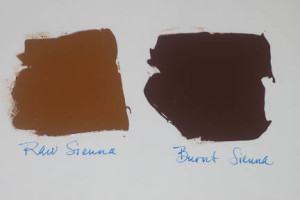 Limonite clay is a main ingredient in the pigment family called sienna. Raw sienna is described as a dull brownish yellow, which in spite of its dullness, is very versatile and widely used by artists. I have used it for the shady side of yellow objects, in backgrounds, and even fleshtones. It also is a perfect color, used alone, as a shadow tone for white objects such as sheet music, pages of books, and white textiles and fabrics.
Limonite clay is a main ingredient in the pigment family called sienna. Raw sienna is described as a dull brownish yellow, which in spite of its dullness, is very versatile and widely used by artists. I have used it for the shady side of yellow objects, in backgrounds, and even fleshtones. It also is a perfect color, used alone, as a shadow tone for white objects such as sheet music, pages of books, and white textiles and fabrics.
Even after a painstaking effort of levigation (separating the particle sizes with water) the siennas retain a very desirable toothy texture. Raw sienna is lightfast, transparent which makes it a splendid glazing color. Another very important characteristic is the excellent drying time.
Raw sienna has a very high oil absorption, up to 100%, thus will darken considerably after grinding into a paint, as you can see here. According to Kurt Wehlte in The Materials and Techniques of Painting, "sienna is one of the ancient pigments whose appearance and durability has never been matched, let alone surpassed, by modern industrial products.
